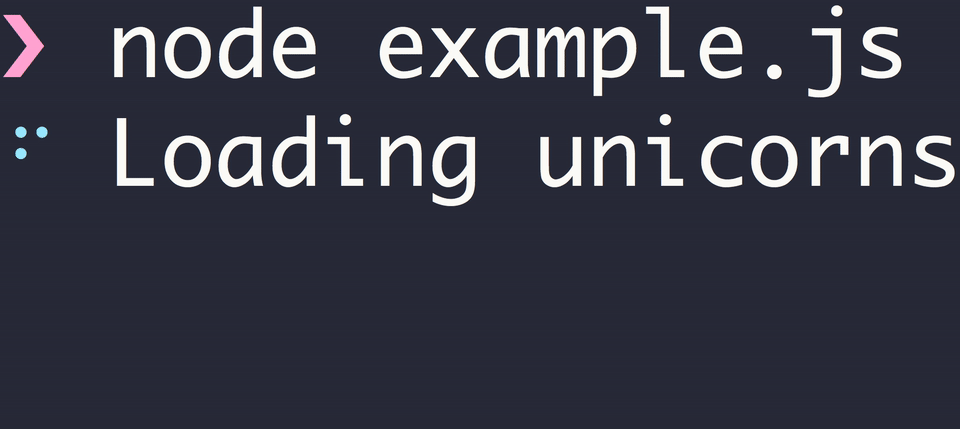ora
Elegant terminal spinner
Elegant terminal spinner
npm install oraCheck out yocto-spinner for a smaller alternative.
import ora from 'ora';
const spinner = ora('Loading unicorns').start();
setTimeout(() => {
spinner.color = 'yellow';
spinner.text = 'Loading rainbows';
}, 1000);If a string is provided, it is treated as a shortcut for options.text.
Type: object
Type: string
The text to display next to the spinner.
Type: string | () => string
Text or a function that returns text to display before the spinner. No prefix text will be displayed if set to an empty string.
Type: string | () => string
Text or a function that returns text to display after the spinner text. No suffix text will be displayed if set to an empty string.
Type: string | object
Default: 'dots' ![]()
The name of one of the provided spinners. See example.js in this repo if you want to test out different spinners. On Windows (except for Windows Terminal), it will always use the line spinner as the Windows command-line doesn't have proper Unicode support.
Or an object like:
{
frames: ['-', '+', '-'],
interval: 80 // Optional
}Type: string
Default: 'cyan'
Values: 'black' | 'red' | 'green' | 'yellow' | 'blue' | 'magenta' | 'cyan' | 'white' | 'gray'
The color of the spinner.
Type: boolean
Default: true
Set to false to stop Ora from hiding the cursor.
Type: number
Default: 0
Indent the spinner with the given number of spaces.
Type: number
Default: Provided by the spinner or 100
Interval between each frame.
Spinners provide their own recommended interval, so you don't really need to specify this.
Type: stream.Writable
Default: process.stderr
Stream to write the output.
You could for example set this to process.stdout instead.
Type: boolean
Force enable/disable the spinner. If not specified, the spinner will be enabled if the stream is being run inside a TTY context (not spawned or piped) and/or not in a CI environment.
Note that {isEnabled: false} doesn't mean it won't output anything. It just means it won't output the spinner, colors, and other ansi escape codes. It will still log text.
Type: boolean
Default: false
Disable the spinner and all log text. All output is suppressed and isEnabled will be considered false.
Type: boolean
Default: true
Discard stdin input (except Ctrl+C) while running if it's TTY. This prevents the spinner from twitching on input, outputting broken lines on Enter key presses, and prevents buffering of input while the spinner is running.
This has no effect on Windows as there is no good way to implement discarding stdin properly there.
Change the text displayed after the spinner.
Change the text before the spinner.
No prefix text will be displayed if set to an empty string.
Change the text after the spinner text.
No suffix text will be displayed if set to an empty string.
Change the spinner color.
Change the spinner.
Change the spinner indent.
A boolean indicating whether the instance is currently spinning.
The interval between each frame.
The interval is decided by the chosen spinner.
Start the spinner. Returns the instance. Set the current text if text is provided.
Stop and clear the spinner. Returns the instance.
Stop the spinner, change it to a green ✔ and persist the current text, or text if provided. Returns the instance. See the GIF below.
Stop the spinner, change it to a red ✖ and persist the current text, or text if provided. Returns the instance. See the GIF below.
Stop the spinner, change it to a yellow ⚠ and persist the current text, or text if provided. Returns the instance.
Stop the spinner, change it to a blue ℹ and persist the current text, or text if provided. Returns the instance.
Stop the spinner and change the symbol or text. Returns the instance. See the GIF below.
Type: object
Type: string
Default: ' '
Symbol to replace the spinner with.
Type: string
Default: Current 'text'
Text to be persisted after the symbol.
Type: string | () => string
Default: Current prefixText
Text or a function that returns text to be persisted before the symbol. No prefix text will be displayed if set to an empty string.
Type: string | () => string
Default: Current suffixText
Text or a function that returns text to be persisted after the text after the symbol. No suffix text will be displayed if set to an empty string.
Clear the spinner. Returns the instance.
Manually render a new frame. Returns the instance.
Get a new frame.
Starts a spinner for a promise or promise-returning function. The spinner is stopped with .succeed() if the promise fulfills or with .fail() if it rejects. Returns the promise.
import {oraPromise} from 'ora';
await oraPromise(somePromise);Type: Promise | ((spinner: ora.Ora) => Promise)
Type: object
All of the options plus the following:
Type: string | ((result: T) => string) | undefined
The new text of the spinner when the promise is resolved.
Keeps the existing text if undefined.
Type: string | ((error: Error) => string) | undefined
The new text of the spinner when the promise is rejected.
Keeps the existing text if undefined.
Type: Record<string, Spinner>
All provided spinners.
Use chalk or yoctocolors:
import ora from 'ora';
import chalk from 'chalk';
const spinner = ora(`Loading ${chalk.red('unicorns')}`).start();JavaScript is single-threaded, so any synchronous operations will block the spinner's animation. To avoid this, prefer using asynchronous operations.
- yocto-spinner - Tiny terminal spinner
- cli-spinners - Spinners for use in the terminal
Ports
- CLISpinner - Terminal spinner library for Swift
- halo - Python port
- spinners - Terminal spinners for Rust
- marquee-ora - Scrolling marquee spinner for Ora
- briandowns/spinner - Terminal spinner/progress indicator for Go
- tj/go-spin - Terminal spinner package for Go
- observablehq.com/@victordidenko/ora - Ora port to Observable notebooks
- kia - Simple terminal spinners for Deno 🦕
